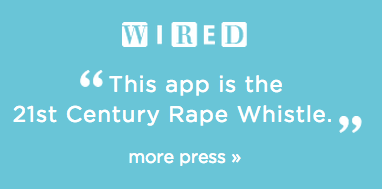Tech projects aimed at women's safety are hot right now: a new one pops up every couple of weeks. It's easy to get excited about them, because violence against women is a persistent problem, and tech holds the promise of a shiny, new, and groundbreaking solution.
But there's a lot below the surface. I've had many conversations on the subject recently, and what I usually do is point people to Jessica Valenti's article, "Why is it easier to invent anti-rape nail polish than to stop rapists?" Then I started thinking, maybe what would be useful is a media-literacy style set of questions to help us think more critically about these projects.
Here are six questions to ask yourself the next time a product or app related to women's safety hits your newsfeed:
1. Who is the target audience for this project?
It's usually college-aged women. This audience is a good fit for this type of product, because there has been significant press around how rape culture affects this group. Rape culture means a culture where sexual violence is normalized, considered inevitable, and joked about (examples here). In rape culture, sexual assault is seen as inevitable, and the responsibility falls to individual women to prevent it from happening by taking self-defense classes, dressing modestly, not going out alone, watching their drink, and GPS tracking their walk home.
So what happens if an assault does occur? It's her fault. Victim-blaming is easy: just point out how she failed to protect herself. It is really important to understand that there is no concept of "ending sexual assault" in a rape culture. Rape culture dictates that sexual assault is an inevitable part of life, and all you can do is make sure the next victim isn't you.
Sub-question: Who is not the target audience for this project? Why not? Sexual assault affects every demographic and every community, some - like trans women of color - at much higher rates than others.
2. What is the purpose?
What specific problem is the project trying to solve? Apps like Circle of 6, Kitestring, and Companion, and wearables like safety jewelry have been released over the past few years, with the purposes of connecting women to friends, family, and authorities who can help in an emergency. They usually focus on sexual assault, often referring to the dangers of "walking home alone," which strongly evokes the image of a stranger rapist in a dark alley (quite literally the least of our problems, since most sexual violence is between people who know each other. I should also mention here that only a tiny fraction of assaults are committed using date rape drugs. Yet these are the two most frequently conjured images in women's safety tech marketing).
Sub-question: What does "prevention" mean? Preventing an individual assault in the moment is one thing. Primary prevention, aka getting to the root of the problem, is something entirely different.
3. Does the app or device refer to itself as a "21st century rape whistle"?
I've recently seen tech safety devices referred to as 21st century rape whistles, or some kind of high-tech mace.
But this tradition goes back even further. Did you know women in the early 1900s were stabbing their harassers with hatpins? Yep. That was 100 years ago. We are reinventing the hatpin.
Sub-questions: What does it mean that we keep coming up with new devices for women to protect themselves? How is this approach working out in terms of solving the problem?
4. How does the project frame the problem it's trying to solve?
A frame is the context in your brain when you're thinking about an issue. The three main frames I've seen used to talk about apps/devices are: as a women's issue, an individual issue, and inevitable.
Women's issue:
How many times have I mentioned the word "men" so far in this piece? Zero. That's funny, because sexual assault is primarily a men's issue. How is it possible that we spend so much time talking about women's role in addressing sexual assault, and so little time talking about men's? This is rape culture in action. While men are very much involved in perpetuating the problem, we see far fewer calls to men to help address it (and yes, there are many ways for men to be an active part of the solution).
A direct quote from Jessica Valenti's article that I love:
As former Israeli prime minister Golda Meir said after a cabinet member suggested that women be given a curfew to curb a spate of sexual assaults: "But it's the men who are attacking the women. If there's to be a curfew, let the men stay home, not the women."
Individual issue:
A product for personal use naturally leads us to imagine solutions on an individual level. What does the opposite frame look like? One example of a community/institutional approach is the powerful movement to hold college campus administrations accountable for complying with Title IX rules for addressing sexual assaults on campus. Because lots of schools, who have far more power and influence than any individual with a rape whistle, aren't even meeting their baseline responsibilities. Check out the big name schools on the investigation list.
Inevitable:
Treating a problem as inevitable only perpetuates it. Think about how persistently advertisers have insisted that men are incompetent as parents and confused by housework. It's equally offensive to equate masculinity with the inability to control oneself around unwatched drinks and skirts that are too short.
Sub-questions: When you're looking at the latest app/device, do you notice these or any other frames?
5. Who are the project's main supporters?
Take a look at the "About Us" section of the project's website. Are organizations working on violence prevention issues partnering on this project, partnering in development, or advising? Why or why not? Are there any quotes or testimonials from experts in the sexual assault prevention field?
Sub-question: What do you know about these experts? Joe Biden has gotten some great things done, but that doesn't mean he always gets it. Just because someone is a big name doesn't mean you shouldn't take a critical approach.
6. Who is talking about it?
Take a look at the press section. If you see lots of great press from tech and business news sources, but nothing from social justice/violence prevention/feminist outlets, ask yourself why. Do some googling and twitter searching. If the project is getting enthusiastic coverage from people who know very little about sexual assault prevention (think: your local news station, or national tech leaders) what does that mean?
Sub-question: What does it mean if you're not finding anything negative, but the expert community is not saying a word?
Thinking critically does not mean dismissing
A hundred years ago, women used their hatpins for self-defense because they needed to. Today, a woman using a high-tech safety product is doing the same thing. Because she's still unsafe. So I'm not going to say that the latest women's safety tech device is useless. What I am going to say is "are we going to be doing the same thing in 2050?" We need to start asking ourselves why we're stuck in this loop.
That means challenging the way we think about the problem. A focus on short-term, individual solutions keeps us locked in a narrow perception of what the problem is. These solutions do not challenge rape culture. They sustain it.
To quote Soraya Chemaly,
"It's really hard for some people to understand why anyone, and especially feminists, would reject a new product like anti-rape nail polish -- how could you reject something that could help stop rape? But those people are thinking about their individual safety, their children's safety, and not interested in all in attacking the systems that create the larger problem. That's not rape prevention, but rape avoidance."
Other approaches to women's safety
So how do we challenge rape culture and approach the problem in a different way? I'm not an expert, but the three things I see most often are:
- Hold rapists accountable
- Support survivors
- Focus on early education
Can tech play a role in any of these? For sure. Projects like Callisto, a survivor-focused college sexual assault reporting system, is taking steps towards holding rapists accountable, and social media plays a huge role in connecting and educating people around victim blaming. As far as early education, I don't know of any tech solutions for things like teaching kids about consent.
There are lots of ways to think about the complexities of this problem, and I welcome your perspectives and resources.

